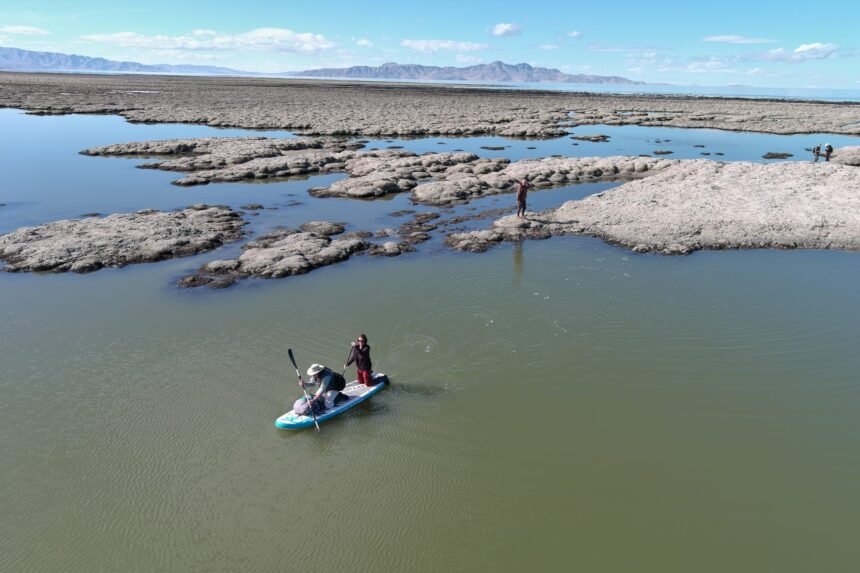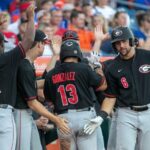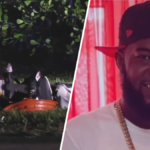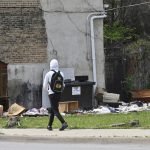Baxter replied, “My data needs your broken heart.”
Exchanges like this are not unusual for Baxter these days. Twenty-six years ago, she was drawn to the Great Salt Lake out of curiosity about the extreme lifeforms living there. Now, she’s studying the limits of life there as the lake level drops, the salinity spikes and species — from brine flies to birds — change their behavior or die off. Baxter initially pursued science to understand how things work, not necessarily to solve problems.
But researching a dying ecosystem has changed her. She prides herself on communicating complex science in digestible ways; for example, she wrote an obituary for the lake — working with Jaimi Butler, a former colleague — in order to wake people up to the crisis. As public awareness has grown, Baxter has made herself a consistent resource for advocates and decision-makers. She shares accessible science with organizers to inform their campaigns and get the word out about what’s happening with the lake, and she also guides government officials as a member of the state’s Great Salt Lake Technical Team.
High Country News recently spoke with Baxter about the status of the Great Salt Lake, the emotional toll on scientists and the steps needed to prevent ecosystem collapse.
This conversation has been edited for length and clarity.
High Country News: In a nutshell, what is the crisis at the Great Salt Lake?
Bonnie Baxter: It’s largely about the watershed as opposed to the lake. Saline lakes are canaries in the coal mine because they’re at the bottom of a watershed. If we use too much water upstream, it doesn’t make it to the bottom of the watershed. And with the pressures of climate change, as temperatures go up, we increase the rate of evaporation. The lake is reporting on the activities of humans. It’s telling us that we’re using too much water, and the Earth is warming too quickly. So the crisis really boils down to a lack of water flowing into the lake.
HCN: When did you realize the lake was in crisis?
BB: When I first started studying the lake, the lake elevations were healthy. It never entered my mind that we would start to see the elevation drop year after year after year. In the early 2000s, there were like six straight years of drought. I was new to the Western United States, so that was the first time I thought, wow, something’s going on. Then we had a good snow year, and I thought, well, that’s the way things go in the West, things are up and down.
Then we had another 10 years of drought, and somewhere in the middle of that, I looked at the graphs and saw the elevation was doing nothing but going down. In 2011, we had a good snow year, but all of the aquifers had to be re-saturated and all of the reservoirs had to be refilled, so none of that water trickled down to the lake. That was the first time I was shocked into understanding there was a problem.
“Suddenly, I’m studying the decimation of our planet by human activity. The feelings about that have snuck up on me too. I wasn’t prepared.”
HCN: How does it feel to study an ecosystem on the brink of collapse?
BB: I did not go to graduate school to study climate change. I was interested in biochemistry; I studied DNA repair. So, it snuck up on me: Suddenly, I’m studying the decimation of our planet by human activity. The feelings about that have snuck up on me too. I wasn’t prepared. I have kids who are in their early 20s, and I teach students who are around 20. Looking at the world through their eyes and their fears has impacted me. I’ve taken on the weightiness of that in this latter part of my career, because I think it’s the most important thing I could be doing.

HCN: Can you expand on that? How are your students doing?
BB: I see in them optimism. Once we’ve been on the planet for a while, we get a little jaded, and the optimism is invigorating. I see hope for their future, because how do you go forward without hope? You can’t. So what’s surprising is — I’m gonna cry when I’m talking about this — I see a desire to make their world a better place. And I just think that’s beautiful. Most people characterize youth today as being nihilistic and maybe a little emo, but it gives you a bounce in your step when you see that they’re working toward good things.
HCN: You have also talked about climate grief with your students. What have those conversations been like?
BB: Britt Wray, (an author and researcher) who has written about climate grief, gave a talk a short while ago, and I took my students. That’s not a usual thing that a science professor does; I’m usually taking my students to science lectures, or lecturing at them myself, or spending time in the field. It’s a little odd to say, “Do you want to go to this humanities program and hear this person talk about climate grief?” The students were excited. It also opened up this unique concept for me because I was raised in a very patriarchal structure where emotions and personal motivations are not part of your science.
After that talk, I felt like we needed to debrief. So we put together a Zoom conversation with a psychologist, and she led a group therapy session. She had us talk about our feelings when we’re watching this lake disappear and we’re watching this ecosystem crash. To hear my students put words to that was just transformative for me. It made it OK for me to start talking about my feelings, and I think it made me more emotional. I mean, I would go out to the lake, and I’d get back in the van and I would cry. But I wouldn’t do that in front of people. Now I’ll cry on TV. These conversations with my students have changed me.
HCN: For years, the Great Salt Lake was largely ignored or even disdained by the average Utahn. What’s it like to study a place that received little attention, but is suddenly all over the media and state politics?

BB: The number of new contacts I have about Great Salt Lake is probably on the order of 30 a week. Some of those are journalists. Some are concerned citizens. Some are people trying to sell me some technology that will save the lake. It’s all walks of life, and it takes a lot to manage; I don’t have staff to answer the phone.
I have people reach out who could make a difference, like the U.S. Geological Survey wants to know what they should do about brine flies. Then the president of the Rockefeller Foundation was like, “I’m gonna be in Salt Lake City, can you take me to the lake?” But that’s no more important than the grandma in Tooele County who calls me and says, “I used to write poetry on my grandpa’s back porch while I watched the lake, and now I can’t see it anymore.”
HCN: At the Stegner Symposium last year, Gov. (Spencer) Cox told scientists to ease up on the doom and gloom. You, in the closing session, then said, “I’m just going to end by putting an asterisk on that optimism — that the timeline is short. We need to get water to the lake and we need to do it quickly.” How did it feel to have the governor tell scientists to be more positive?
BB: I was appalled by the governor’s words. One of the things he said was in response to the call for the state to set a healthy elevation range for the lake. His response was basically, “We know what the elevation range is, I have a poster in my office that has the elevation range on it, why do we need to set it?” I think he missed the point. His snarky response did not address the real question, which was: What happens when we aren’t in that range? What are those emergency procedures? And can we get those on paper? He glossed over that. I felt like he made fun of the scientists. So many of us were offended. And by the way, we’re not in range. Despite (the) last snow year, we’re still not in range.
HCN: Do you think ecosystem collapse can be prevented?
BB: Yes, I think it can. It’s a water equation. We just need to get more water into the system. The question that is hard to answer is, how do you track that water? They call it shepherding. Like if Farmer Jane is not going to use all of her water rights and she wants to lease her rights back to the state, how do you know that Farmer Joe downstream is not just using more water? How do you know Jane’s water actually makes it to the lake? Measuring and watching that water is a laborious process, and the state is not quite there yet.
HCN: What’s next for you in your work?
BB: I’m starting to think more holistically beyond Great Salt Lake to other saline lakes. We have not saved one yet. Some have died. Some are on their way to dying. So, I think we could learn a lot from each other. I also think it’s important that every conversation about water at the state and federal level have Indigenous representation, so I’m trying to put together stakeholder groups around saline lakes in the West that will have Indigenous representation. For a molecular biologist who studies the tiniest things in the world to think that my role should be going bigger might be counterintuitive, but I think that’s where the solutions lie.

Brooke Larsen is the Virginia Spencer Davis Fellow for HCN, covering rural communities, agriculture and conservation. She reports from Salt Lake City, Utah. Email her at brooke.larsen@hcn.org or submit a letter to the editor. See our letters to the editor policy. Follow her on Instagram @jbrookelarsen or Twitter @JBrookeLarsen.











